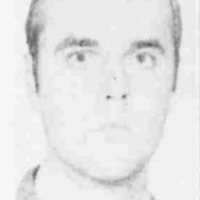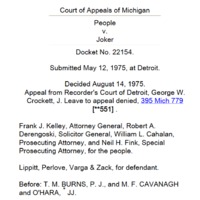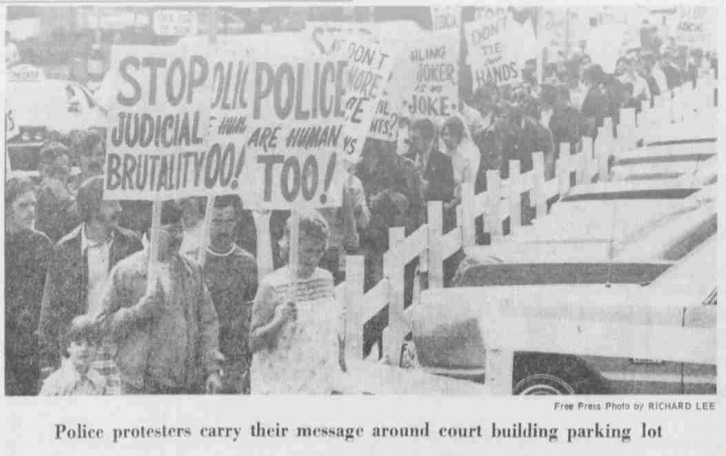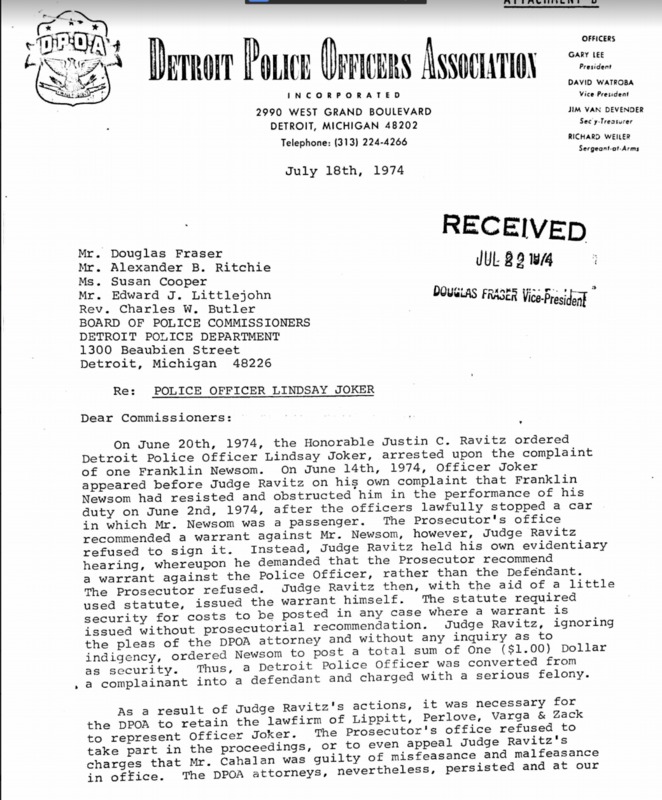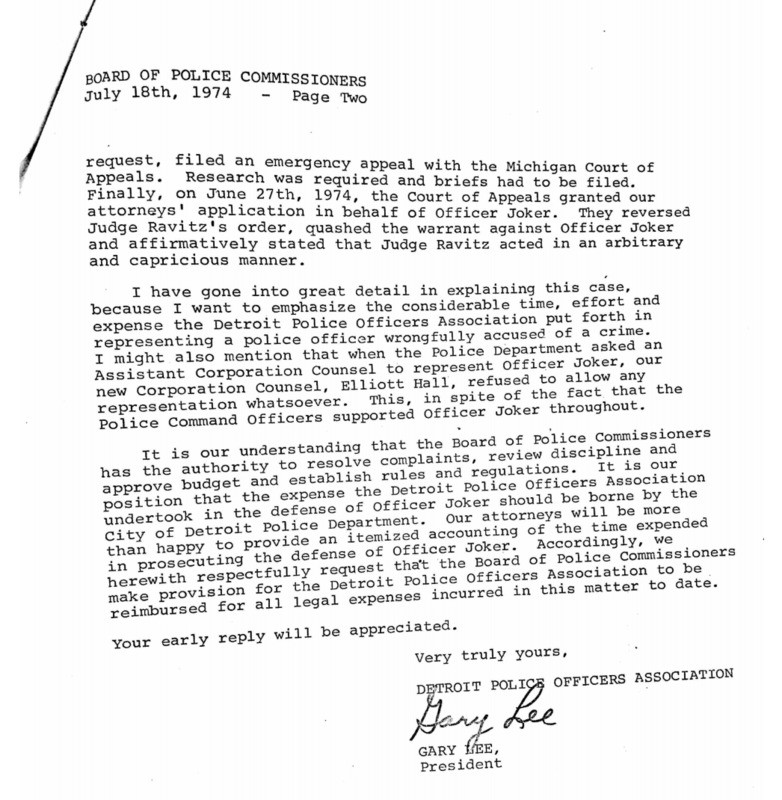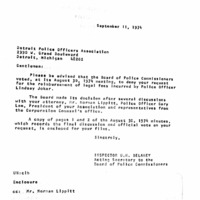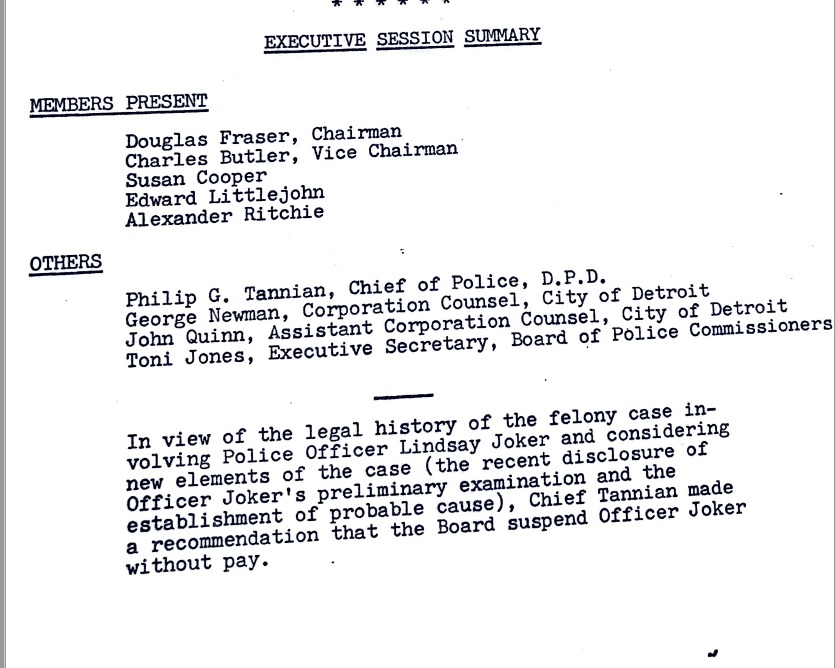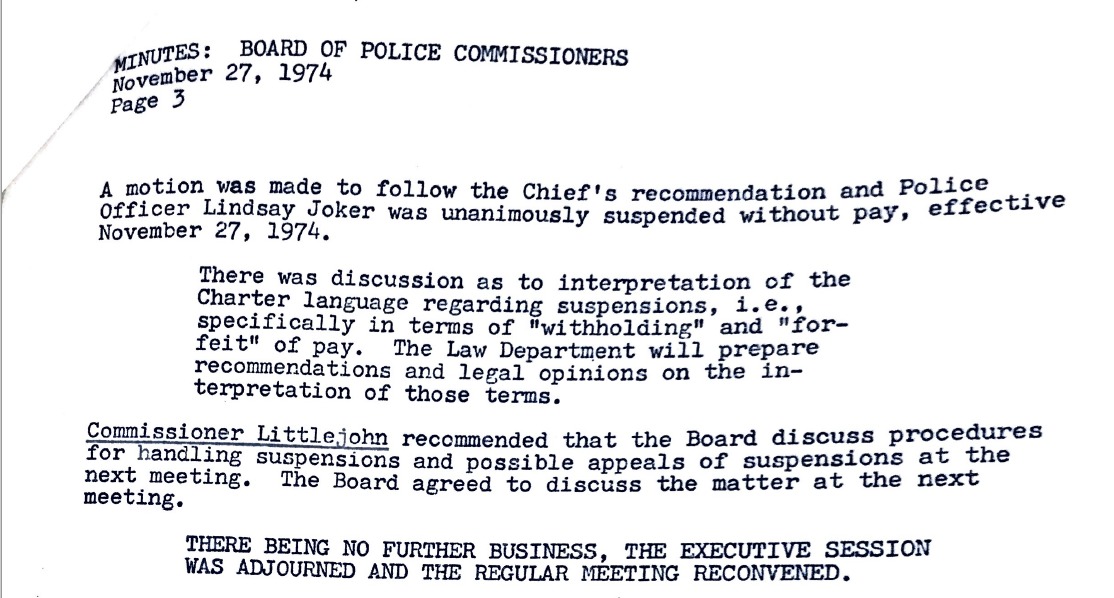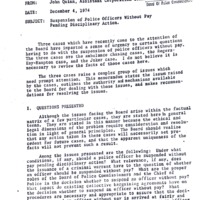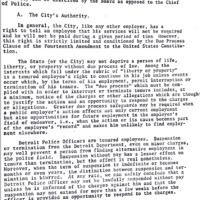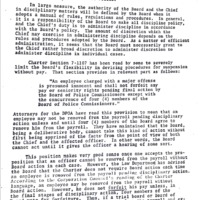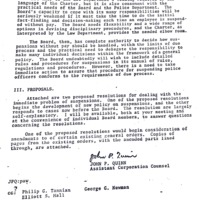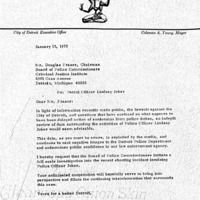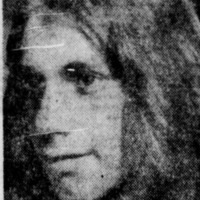IN-FOCUS: Lindsay Joker
Lindsay Joker
Lindsay Joker is an example of a “repeat offender” officer. Officer Joker joined the Detroit Police Department (DPD) in 1972, during the peak of the STRESS era when the DPD killed 22 civilians. Within the first five months of Coleman Young's inauguration, Joker is assaulted Charles Brown, Ralph Scott, and Franklin Newsom. Joker's first lawsuit was in response to the Newsom assault in May of 1974. It is unlikely assaulting during an arrest was a new habit acquired, but rather with Young in office, Joker was new to getting caught.
While there were several officers who repeatedly engaged in racist violence, it is important to note it appears to be a systemic issue. Former Detroit Police chief Ike McKinnon, who was an officer in the DPD for nearly 30 years, denies that police violence against Black civilians can be reduced to a few racist officers. Rather, he states "policemen cannot avoid physical confrontation." Joker in his own testimony stated that the force was necessary to subdue Newsom. It was not considered improper conduct. The DPOA, or Detroit Police Officer Association, was primarily composed of white officers and historically racist and conservative. [For more on the DPOA click here].
Ravitz vs DPOA
Franklin Newsom was Joker’s third target. It was this assault that landed Joker in court for the first time. In court, Joker testified against Newsom for obstructing justice and resisting arrest. Newsom mentioned that Joker beat him with a flashlight. Due to Newsom’s allegations, Judge Ravitz threw out the charge of obstructing justice and resisting arrest against Newsom and ordered Joker arrested on charges of felonious assault. The Wayne County Prosecutor refused to prosecute Joker and Ravitz issued the warrant himself. Ravitz was a radical leftist attorney and the first in the nation to be elected as a judge according to the New York Times archive. As an attorney he maintained a dedication to justice within a racist system. Ravitz filed a suit against STRESS, (link) the aforementioned decoy cop operation, and proved the court system was illegally disqualifying thousands of primarily African American and poor citizens from jury duty. He was the DPOA's worst nightmare.
As shown in the second of the two newspaper titles, the media largely "blamed" Ravitz for Joker's arrest. The articles themselves continually quoted Gary Lee, the president of the DPOA, and other DPOA members but never asked the Judge about the case. Gary Lee was cited continuously, arguing that they were persecuting an innocent man. In the context of Affirmative Action policies and white cops already feeling slighted from promotions, Gary Lee capitalized off of the anger. He launched an Anti-Ravitz protest, very reminiscent of the "blue lives matter" protests that we see today in opposition to the Black Lives Matter movement. The Detroit Free Press, by failing to include Ravitz's narrative frame Lee and Joker's stories as truth. The one-sided reporting is incredibly irresponsible. The paper did not critique the protest at all but rather called it a "civilized" and "quiet" march. This sits in sharp comparison to civil rights protests, led by the African American community, that are labeled as "riots."
To Lee, the Ravitz ruling was indicative of an administration moving away from supporting officers, and he felt his power threatened. An estimated 200 officers showed up in protest. Protesters carried signs of "Judicial Brutality" equating the injustice they felt to the violence officers regularly inflict upon civilians. Gary Lee and many others believed physical force is apart of the job. The accepted narrative saw Joker as a sort of martyr, victim to liberal administrators and policies. In the eyes of the DPOA, Newsom was exaggerating -- Joker did no wrong. Moreover, there was a lot of anxiety present in the department. Lee and the DPOA feared that there would be mass resignations if the police did not get support from the administration.
Ultimately, Joker was “reprimanded” but allowed to stay on the force. The DPOA took on Joker and hired him an attorney, Norman Lippit, and the union covered all legal fees. Gary Lee later wrote the Board of Police Commissioners and petitioned to receive reimbursement for the cost claiming that it was the City's responsibility to take on the cost for their wrongdoing. The request was rejected. Denying this request implies the Police Commissioners knew Joker was guilty, and yet nothing else is done. Joker returned to the force.
Police Commissioners Minutes
In the months of October and November, Lindsay Joker's name was everywhere. He became a regular topic of discussion at the Board of Police Commissioners meetings, deciding what to do about the lawsuits. Notably, we do not have access to the executive board minutes, where most of the decisions were made, particularly when it involved an officer being charged. Joker's case fit into a larger conversation around suspension procedures and provoked the board to standardize the protocol for future instances of brutality. Mayor Young was upset with the magnitude of the reporting around the Officer's case and formally requested the board launch an investigation. Notably, his comment was in the context of bad press for the department, with no mention of Winstead or justice for the victim.
Below is a report by John Quinn, Assistant Corporation Council on the new procedures. Quinn is largely discussing his drafted proposal for the new procedures on handling instances of suspension without pay. The Board of Police Commissioners was very new, and Quinn was adamant that the city was watching. The decision and procedures established in this case would inevitably serve as the precedent for any future cases of police brutality. The Board had to establish their power, and Quinn thought it was wise to formalize a written procedure.
Quinn's Report on Suspensions
At the point of Quinn drafting the document, Larry Winstead had already been killed. He was interpreting the new charter and working to establish a more formalized procedure, which was essentially focused on differentiating withholding and forfeiture of pay. The law department felt that the board had complete authority to decide how suspensions should be handled, and Quinn proposed two resolutions. The first begins with the development of a new policy on suspensions and the other response to current cases in front of the board. In regard to the current cases, Quinn makes the distinction between offers that have been suspended for less than a year and over a year, giving them, with some caveats, the opportunity to be reinstated upon facing a trial board. Quinn is also especially concerned with "due process." The 14th amendment to the United States Consitution ensures that all citizens enjoy the right to life, liberty and property which cannot be taken away without due process. Included in this was the complication that Officers were considered tenured employees and without the right to a trial, to be suspended for an extended period of time without pay is in violation of the US constitution. He states there is a greater responsibility for due process considering an officer found guilty of abusing a civilian would have a very hard time finding work within the field. While that should be the case, Quinn's point is that the city has some responsibility to ensure that the individual can take care of themselves after the case is resolved.
Larry Winstead
Five months later on October 24, Joker shot and killed Larry Winstead (20) in the parking lot of Biff's Restaraunt. It was around 3 a.m. and an intoxicated Joker was leaving a DPOA event and walking to his car when Winstead had apparently almost hit Joker with his car. Winstead got out of the vehicle and Joker shot Winstead once in the chest. Winstead died en route to the hospital.
Joker was off duty at the time of the killing. Had Joker been suspended, he would have not been allowed to identify himself as an officer or have his personal revolver and Winstead would have lived. The personal revolver required a private permit he would not have been issued had the suspension been sustained. This sparked outrage in Winstead's family and led to the $12 million case which was appealed up to the Supreme Court.
There were no witnesses at the time of the incident, only Joker and his partner Napora. According to friends of Winstead, this was not the first time the young man was in contact with Joker. Apparently Joker at one point said "I'm going to get you" to Winstead however the context of this phrase is contested. Friends of Joker claim the pair were racing and it was in competitive jest. Regardless, Winstead was not a stranger to the Officer and yet Joker fired.
Winstead's parents are in disbelief that their apparently physically small son would attack two armed officers. Furthermore, as the Free Press reports, there are seven individuals who agree that the razor Joker presented could not have been Winstead's. The department admits there were no fingerprints that on it but that this lack of DNA is not unusual. In several other homicides, the officers report random objects being used as weapons against them, justifying their gunshot as self-defense. This case provides evidence to doubt such claims. More likely, the officer is aware of the power of "self-defense" and maybe it is common knowledge that so long as they have a weapon, whatever that weapon maybe, the officers know they can continue without punishment.
The Verdict
At the end of the case, Joker was asked to leave the DPD without pay. He was suspended on November 27, 1974. After two years, he was called to return to active duty by Cheif William Hart on November 4, 1976 and given $25,000 back in pay.
Sources for this page
ike McKinnon interview
The New York Times, 12 November 1972
https://www.nytimes.com/1972/11/12/archives/detroit-lawyer-becomes-first-radical-judge-in-us.html

